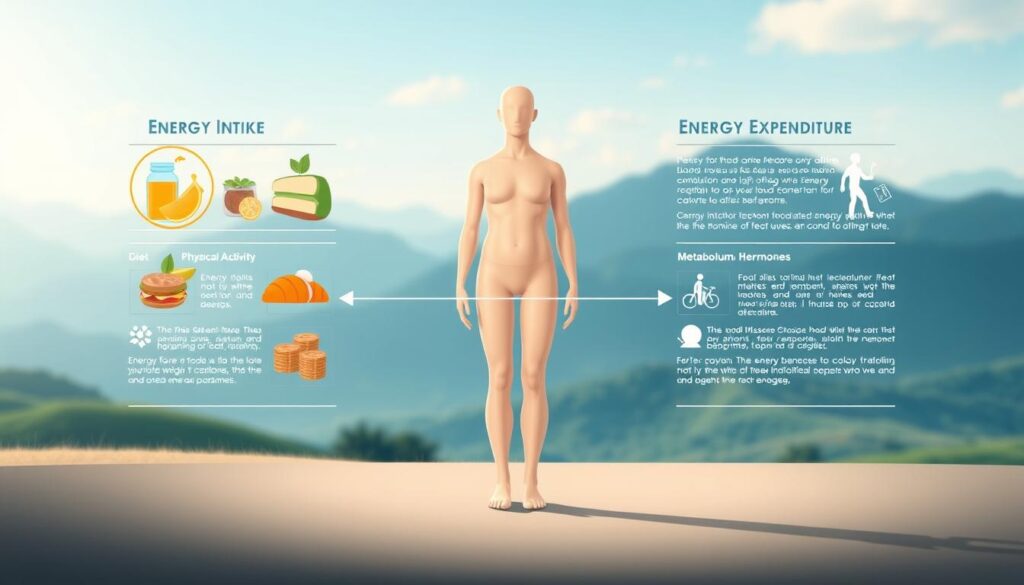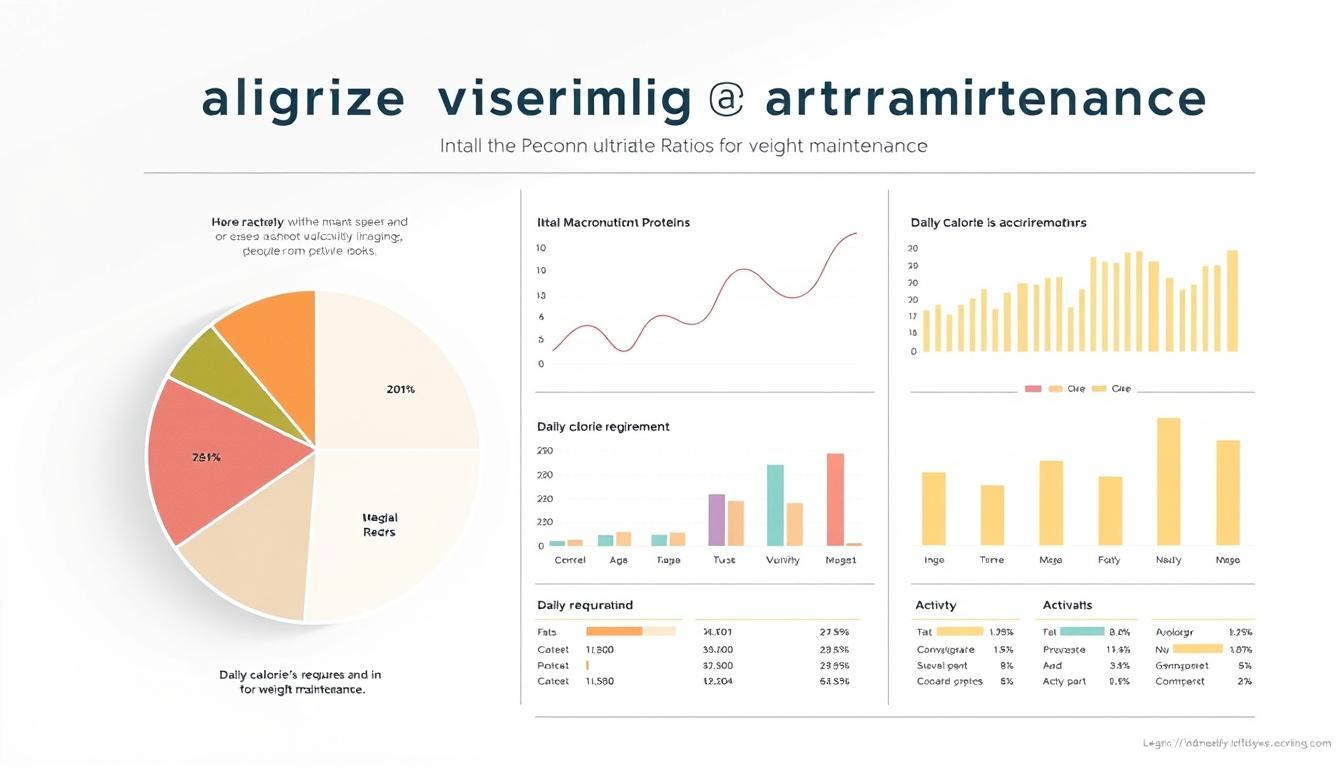What if everything you know about calorie needs is wrong? Most people assume sticking to a generic number like 2,000 calories daily works for everyone. But research shows individual needs vary wildly. For example, women often require at least 1,600 calories, while men may need 2,000 or more—depending on factors like activity and body composition.
We’ve crafted this guide to help you navigate the science of energy balance. A one-size-fits-all approach rarely accounts for lifestyle, metabolism, or fitness goals. That’s why tailoring your plan matters. Whether aiming to lose or sustain weight, understanding your unique requirements is the first step.
Activity level and body weight play pivotal roles. A sedentary office worker burns fewer calories than a construction worker, even if they weigh the same. Tools like scientifically validated calculators simplify tracking, but personalization remains key. We’ll show you how to build a flexible strategy that adapts to your life.
Key Takeaways
- Calorie needs differ by gender, activity, and body weight.
- Structured plans improve long-term energy balance.
- Individual factors determine ideal intake levels.
- Consistency matters more than short-term restrictions.
- Science-backed tools provide reliable guidance.
Introduction to Calorie Intake and Weight Maintenance
The secret to weight control lies in understanding energy balance. Think of it as a scale: what you consume versus what your body uses. Even a 10% daily mismatch can shift pounds over time.

The Importance of Calorie Balance
Consuming more energy than you burn leads to weight gain, while a deficit triggers loss. Research shows a 500-calorie daily gap changes body mass by roughly 1 pound weekly. This principle applies whether aiming for stability or gradual loss.
Quality matters as much as quantity. Nutrient-dense foods keep hunger at bay, making balance sustainable. A meal rich in protein and fiber supports steady energy better than empty calories from processed snacks.
Factors Influencing Caloric Needs
Your activity level and current weight shape daily requirements. A 180-pound athlete needs more fuel than a sedentary person weighing 140 pounds. Age and genetics also play roles—metabolism slows by 3-8% per decade after 30.
Tools like our online calorie calculator simplify tracking. They account for physical activity, body composition, and goals. Pair this data with mindful eating for lasting results.
Understanding Your Caloric Needs
Your body’s energy demands are as unique as your fingerprint. To maintain or change your weight, you need precise insights into what fuels your daily functions. This starts with two core elements: basal metabolic rate (BMR) and physical activity.

Basal Metabolic Rate and Activity Level
BMR represents the calories your body burns at rest. Formulas like the Mifflin-St Jeor equation calculate this using age, current weight, and height. For example, a 30-year-old woman weighing 150 pounds may need 1,400 calories daily just for breathing and organ function.
Activity level acts as a multiplier. Sedentary lifestyles add 20% to BMR, while intense training can double it. Construction workers often require 3,000+ calories—office workers might need 30% less, even at similar weights.
Using Calorie Calculators for Personalization
Online tools simplify this math. Enter your age, body measurements, and exercise habits. The calculator applies scientific formulas like the Estimated Energy Requirement. Muscle mass plays a hidden role here—it burns 3x more calories than fat tissue.
Interpreting Daily Calorie Budgets
Results show a target range, not a fixed number. A 200-calorie swing daily can shift weight by 2 pounds monthly. For maintenance, aim for the middle of your range. If weight loss is the goal, subtract 10-15% from the total.
Track changes over weeks, not days. Bodies adapt to new routines. Adjust intake based on progress and energy levels. Remember: Precision beats guesswork.
How to adjust calorie intake for weight maintenance
Tracking your daily fuel usage reveals patterns most people overlook. Start by logging meals for three days using apps like MyFitnessPal. Compare results to your calculated maintenance range—this shows where adjustments matter.
Assessing Your Current Calorie Intake
Food diaries expose hidden habits. A 160-pound office worker might discover they’re eating 2,400 calories despite needing only 2,000. Small discrepancies add up—500 extra daily calories lead to 1 pound gained weekly.
Use digital scales for accuracy. Pre-packaged items often list misleading portions. Measure oils, nuts, and snacks—they’re common culprits in energy overconsumption.
Adjusting Your Intake Based on Goals
For gradual weight loss, trim 250-500 calories daily. This creates a 1-2 pound deficit weekly without starvation. Swap sugary drinks for sparkling water. Choose grilled proteins over fried options.
Those aiming to gain mass add 300-500 calories through nutrient-rich foods. Blend oats into smoothies or snack on almond butter. Metabolic rate determines how quickly changes appear—patience is key.
Re-evaluate every 4 weeks. If progress stalls, tweak intake by 5-10%. Bodies adapt, so flexibility ensures long-term success.
Calorie Counting, Tools, and Personalized Strategies
Digital tools transform guesswork into precision for managing energy balance. Unlike paper logs, modern apps sync with fitness trackers and offer real-time adjustments. This creates dynamic plans that adapt to your lifestyle.
Leveraging Online Calorie Calculators
Platforms like the calorie calculator use formulas accounting for age, weight, and exercise habits. Enter your data once—it estimates needs within seconds. Activity level heavily influences results. A runner gets higher targets than someone with desk jobs.
These tools simplify complex math. They factor in calories burned through daily tasks and workouts. For accuracy, update your profile when routines change. Consistency matters more than perfection.
Customizing Your Calorie Budget with MyNetDiary
Apps like MyNetDiary take personalization further. Set protein goals or carb limits while tracking food intake. Logging a 30-minute jog automatically adds burned calories to your daily allowance. This prevents underfueling after intense workouts.
Users report better adherence with visual dashboards. Seeing a 500-calorie deficit motivates smarter choices. Pair this with the calorie deficit planner for targeted weight loss strategies.
Weekly reviews highlight trends. Did stress snacking spike every Tuesday? Adjust meal plan portions beforehand. Tools empower—they don’t dictate.
Balancing Macronutrients and Physical Activity
Fueling your body effectively requires more than counting numbers. The right mix of nutrients paired with movement creates a powerful synergy for sustainable results. Let’s explore how protein and smart exercise choices amplify your efforts.
Protein’s Power in Body Composition
Protein builds and preserves muscle mass while keeping hunger in check. Studies show diets with 25-30% protein reduce cravings by 60% compared to low-protein plans. Aim for lean sources like chicken, lentils, or Greek yogurt at every meal.
Exercise Types and Energy Expenditure
Physical activity shapes your daily calories burned. A 155-pound person torches:
| Activity | 30 Minutes | Calories Burned |
|---|---|---|
| Weight Training | Moderate | 112 |
| Cycling | 12-14 mph | 298 |
| Swimming | Freestyle | 223 |
| Yoga | Vinyasa | 149 |
Combine resistance training with cardio for maximum impact. This dual approach boosts metabolism for hours post-workout.
Creating Active Daily Routines
Small changes yield big results. Take stairs instead of elevators. Walk during phone calls. These micro-movements add 200+ calories burned daily. Pair this with nutrient-dense meals rich in fiber and healthy fats.
Remember: Consistency beats intensity. Three 10-minute walks often prove more sustainable than one exhausting gym session. Track progress using apps that sync with fitness trackers for real-time feedback.
Practical Tips for Daily Calorie Management
Mastering daily food choices requires more than willpower—it demands strategy. Simple systems outperform sheer effort when managing energy balance. We’ll break down methods that fit seamlessly into busy schedules while delivering results.
Meal Planning and Portion Control Strategies
Start with weekly meal prep. Dedicate 90 minutes every Sunday to batch-cook proteins, grains, and veggies. Store them in portioned containers for grab-and-go meals. This cuts impulsive takeout orders that often exceed calorie goals.
Use visual cues for serving sizes:
- A fist-sized portion of carbs
- Palm-sized protein servings
- Thumb-tip measures for oils or nut butter
Track intake using apps like Lose It! for three days per week. Spot trends—like afternoon snack cravings—and stock healthier alternatives. Research shows people underestimate food consumption by 20% without tracking.
Schedule meals every 3-4 hours to stabilize energy levels. Pair snacks with protein and fiber: apple slices with almond butter or Greek yogurt with berries. These choices curb hunger better than processed options.
Reassess your plan weekly. If weight loss stalls, tweak portions by 5% or add 10 minutes of daily activity. Small changes prevent plateaus without drastic diet overhauls. Consistency turns these habits into lifelong tools.
Conclusion
Sustainable weight management hinges on personalization, not universal formulas. Body weight, activity level, and metabolic factors create unique energy needs. A 150-pound athlete requires different fuel than a sedentary person at the same weight—proving one-size plans often fail.
Digital tools like calorie calculators simplify tracking while accounting for muscle mass and exercise habits. Regular check-ins prevent gradual shifts—a 200-calorie daily surplus adds 2 pounds monthly. Apps highlight trends, letting you modify portions before minor changes become significant.
Whether aiming for weight loss or stability, balance remains key. Energy expenditure must align with what you consume. Prioritize protein-rich meals and consistent movement—even small steps like walking meetings burn extra calories.
Reassess your strategy every 4-6 weeks. Bodies adapt, and life changes demand flexibility. Pair smart tracking with patience—lasting results come from informed choices, not quick fixes. Start today: your ideal plan awaits.


